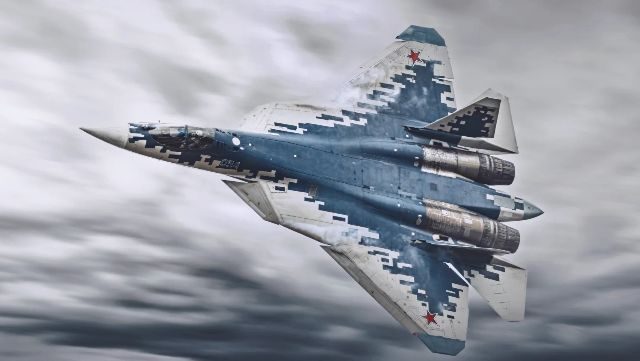In 2024, Russian combat aviation not only demonstrated its capabilities and operability on the battlefield, but also made progress in modernizing and expanding its fleet.

A total of 14 batches of fighters of various configurations were delivered to the Russian Air Force. In 2024, three batches of Su-57s, four batches of Su-35s, six batches of Su-34s, and one batch of Su-30SMs will be delivered. At the moment, the number of fighters included in these batches remains unknown.
Despite continued challenges from the ongoing conflict in Ukraine, Russia’s defense industry has managed to replace a significant portion of aircraft losses, while at the same time increasing production capacity for new fighter jets and helicopters.
This development took place at a time when the Russian Air Force was under considerable stress, especially in view of the escalation of the war and the demanding operational demands on the fleet.
By the end of 2024, Russia’s aviation sector had made significant progress, but production capacity was still under great pressure.
Actual operational use of Su-57 and Su-35 fighters in Ukraine provided an important test of their capabilities and highlighted both their advantages and limitations in intense combat.
The Russian military has set ambitious production targets for the Su-57, but the exact number of aircraft to be delivered in 2024 is still shrouded in uncertainty, and it is unlikely that production will ramp up quickly enough to meet demand. There are conflicting reports pointing to delays and challenges in scaling up.
The Komsomolsk-on-Amur plant in Russia’s Far East played a key role in expanding Su-57 manufacturing efforts.
Despite intensified efforts to increase production, the facility faces significant constraints due to limited resources, impacting its ability to meet high demand.
Although the factory continues to produce Su-35s, these aircraft remain important in Russian operations in Ukraine, particularly in air-to-air combat and air defense suppression roles.
Although not the latest generation, the Su-35 has proven its effectiveness on the battlefield and remains an important component of Russian airpower, although it is inferior to the Su-57 in certain aspects.
Growing international demand for the Su-35 also poses a major challenge for Russia. Iran, in particular, has expressed interest in acquiring the plane, and these deals are likely to continue to grow in the coming years, further straining Russia’s ability to prioritize domestic needs over export deals.
The situation is further exacerbated by reports that other countries, including Indonesia, are still considering options to acquire the Su-35.
Growing global interest in this aircraft and continued use in Ukraine make this aircraft a valuable asset for the Russian defense sector, while at the same time providing the necessary balance to meet both domestic and international needs. It emphasizes that.
Russia’s Su-34 multi-role strike fighter, meanwhile, played a disproportionately large role in the 2024 Ukraine conflict, flying a wide range of missions from airstrikes to precision bombing.
The Su-34 has proven invaluable in combat due to its heavy weapons load and wide operational range.
However, the intense operational tempo in Ukraine resulted in heavy losses, and the Russian Ministry of Defense issued a directive aimed at increasing production.
This effort to expand the Su-34 fleet is consistent with broader strategic priorities, as the Su-34 continues to serve as the mainstay of Russian forces in Ukraine.
Former Minister of Defense Sergei Shoigu emphasized the role of the Su-34, emphasizing the importance of the aircraft as a “workhorse” capable of flying up to four to five sorties a day, and calling it important in the operational framework of the Russian military. The position was emphasized.
Furthermore, the Su-34 produced in 2024 was an enhanced version called the Su-34M, which further modernized the airframe and systems.
These upgraded fighters integrate new avionics and weapons systems, making them more effective against a variety of modern threats, especially in high-intensity conflicts like the one in Ukraine.
The Su-34’s significant weapons carrying capabilities allow it to carry an array of heavy precision weapons, including the new FAB-3000 glide bomb, making it essential to Russia’s long-range strike capabilities.
These updates to the Su-34 fleet are part of a broader effort to ensure this aircraft remains at the forefront of Russian air power.
An important development in 2024 was the continued production and delivery of the Su-30SM2, an upgraded version of the Su-30SM. The aircraft incorporates technology from the Su-35, including the AL-41F1S engine, significantly increasing the aircraft’s flight performance and range.
Although considered a less advanced fighter aircraft than the Su-57, the Su-30SM2 remains an important component of the Russian Air Force due to its versatility, cost-effectiveness, and powerful weapons capacity. Masu.
The aircraft’s enhanced engine and extended range make it a valuable asset for both domestic operations and international sales.
Kazakhstan and Belarus are major international customers, and orders for the Su-30SM2 continue to flow in, even as foreign interest shifts to more advanced platforms like the Su-57.
Looking to the future, Russia is shifting its focus to next-generation aircraft, with the Su-57 at the center of its long-term plans. With the Su-30SM and Su-35 planned to be phased out by 2030, ushering in a new era of advanced combat aircraft, the Su-57 is likely to become the mainstay of the Russian Air Force.
The Irkutsk Aviation Plant, which produces the Su-30SM and Su-30SM2, will play a central role in the modernization of Russia’s fighter fleet in the coming years. However, it remains unclear whether factories can maintain production levels of these legacy aircraft while transitioning to next-generation fighters.
At the same time, Russia’s defense industry continues to focus on modernizing its older aircraft fleet, such as the MiG-31, which remains a critical asset for Russia’s air defense needs. Although the MiG-31 is an aging platform, it has been retrofitted with modern avionics and weapons systems to ensure its continued relevance.
The MiG-31, particularly the MiG-31BM and MiG-31I configurations, remains a valuable asset for both domestic defense and export. This highlights Russia’s strategy to maintain a diverse fleet of aircraft, including both modern and older platforms, enabling a more flexible and adaptable air force.
As 2024 draws to a close, it is clear that Russia’s military aviation industry is undergoing a major transformation, balancing between modernizing existing aircraft and preparing for the next generation of fighters.
Pressure to meet domestic and international demand for advanced combat aircraft while ensuring the continued operation of existing aircraft will continue to be on Russia’s defense industry in the coming years.
The broader geopolitical situation, coupled with the ongoing war in Ukraine, will undoubtedly influence Russia’s defense priorities, with the Air Force at the center of its strategic defense planning.
In conclusion, 2024 was a year of significant progress for Russian combat aviation, but also a year full of challenges, as Russia’s defense industry works to maintain fleet readiness amid ongoing conflicts. there were.
Looking to the future, the Russian Air Force’s ability to modernize its aircraft fleet while balancing domestic and export needs will be crucial in shaping the airpower in the coming years.
With a focus on next-generation platforms like the Su-57, Russia’s aviation industry is poised to remain competitive in the global defense landscape while navigating the complexities of a changing geopolitical environment.
***
Follow us anytime, anywhere. BulgarianMilitary.com has a responsive design, so you can open the page from any computer, mobile device, or web browser. For more up-to-date news, follow us on Google News, YouTube, Reddit, LinkedIn, and Twitter. Our Standards: Manifesto and Ethical Principles.


